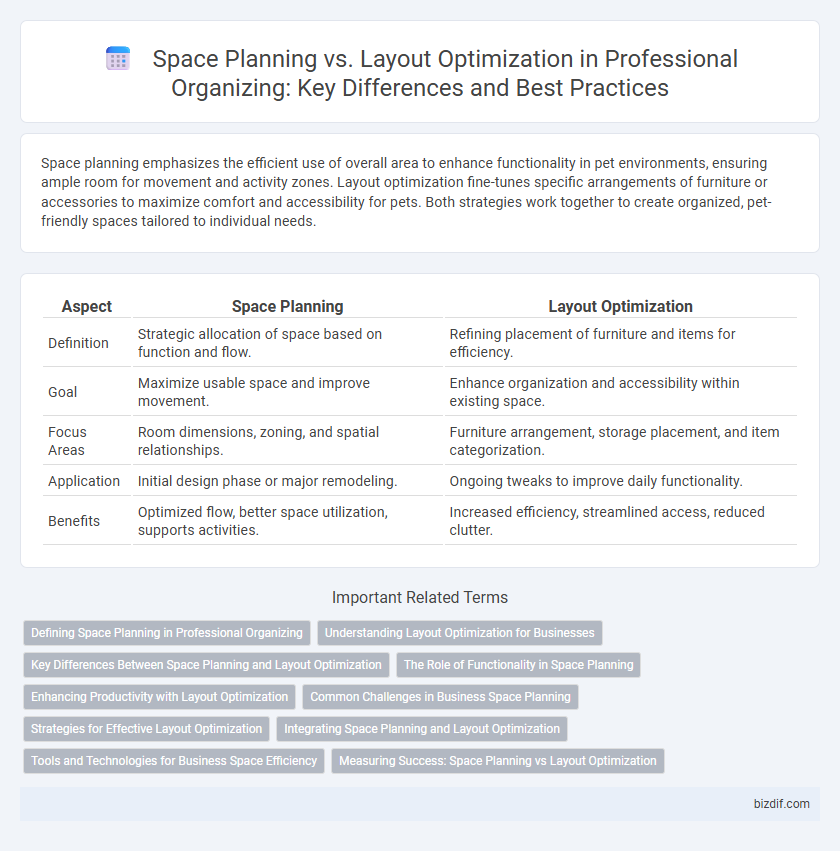Space planning emphasizes the efficient use of overall area to enhance functionality in pet environments, ensuring ample room for movement and activity zones. Layout optimization fine-tunes specific arrangements of furniture or accessories to maximize comfort and accessibility for pets. Both strategies work together to create organized, pet-friendly spaces tailored to individual needs.
Table of Comparison
| Aspect | Space Planning | Layout Optimization |
|---|---|---|
| Definition | Strategic allocation of space based on function and flow. | Refining placement of furniture and items for efficiency. |
| Goal | Maximize usable space and improve movement. | Enhance organization and accessibility within existing space. |
| Focus Areas | Room dimensions, zoning, and spatial relationships. | Furniture arrangement, storage placement, and item categorization. |
| Application | Initial design phase or major remodeling. | Ongoing tweaks to improve daily functionality. |
| Benefits | Optimized flow, better space utilization, supports activities. | Increased efficiency, streamlined access, reduced clutter. |
Defining Space Planning in Professional Organizing
Space planning in professional organizing involves analyzing and allocating physical areas to maximize functionality and flow, ensuring that each zone supports specific activities effectively. It focuses on understanding spatial dimensions, traffic patterns, and storage needs to create an environment that enhances productivity and reduces clutter. Unlike layout optimization, which fine-tunes furniture and item placement, space planning establishes the foundational structure of how a space is used and organized.
Understanding Layout Optimization for Businesses
Layout optimization focuses on arranging physical spaces to maximize efficiency, functionality, and flow within a business environment, directly impacting employee productivity and customer experience. Unlike general space planning, which involves allocating areas and zones, layout optimization integrates detailed analysis of workflow patterns, equipment placement, and traffic movement to minimize waste and streamline operations. Implementing effective layout optimization can lead to reduced operational costs, enhanced safety, and improved overall organizational performance.
Key Differences Between Space Planning and Layout Optimization
Space planning focuses on allocating areas efficiently within a given space to enhance functionality, considering factors like traffic flow and zoning. Layout optimization prioritizes arranging furniture and fixtures to maximize usability and aesthetic appeal while minimizing wasted space. Key differences include space planning's broader scope in overall spatial use versus layout optimization's detailed emphasis on specific placements for improved operational efficiency.
The Role of Functionality in Space Planning
Space planning prioritizes functionality by analyzing how individuals use a space to create efficient, purposeful zones that enhance daily activities. Layout optimization focuses on arranging furniture and elements to maximize flow and usability while minimizing wasted space. Emphasizing functionality ensures that every design choice supports practical needs, improving overall organization and user experience.
Enhancing Productivity with Layout Optimization
Layout optimization enhances productivity by strategically arranging furniture and workstations to maximize efficiency and reduce unnecessary movement. Effective space planning allocates areas for specific tasks, but layout optimization fine-tunes the arrangement to streamline workflows and minimize distractions. Prioritizing ergonomic design and accessibility in layout improves focus and accelerates task completion in professional organizing environments.
Common Challenges in Business Space Planning
Common challenges in business space planning include balancing functionality with aesthetic appeal, managing limited square footage efficiently, and ensuring compliance with safety and accessibility standards. Poorly planned spaces can lead to workflow disruptions, decreased employee productivity, and ineffective use of resources. Addressing these issues requires strategic layout optimization that aligns with organizational goals and operational needs.
Strategies for Effective Layout Optimization
Effective layout optimization in professional organizing hinges on strategic space planning, which assesses room dimensions and user needs to maximize functionality. Prioritizing traffic flow, storage accessibility, and multi-purpose zones creates a cohesive environment that enhances daily efficiency. Incorporating adjustable furniture and modular storage solutions further refines spatial organization, tailoring the layout to evolving lifestyle demands.
Integrating Space Planning and Layout Optimization
Integrating space planning and layout optimization significantly enhances the efficiency and functionality of professional organizing projects by maximizing available space and tailoring arrangements to user needs. Space planning establishes the foundational dimensions and flow, while layout optimization refines the placement of furniture and storage solutions for optimal accessibility and aesthetics. Combining these approaches ensures a cohesive design that boosts productivity and comfort in both residential and commercial environments.
Tools and Technologies for Business Space Efficiency
Space planning and layout optimization leverage advanced tools such as CAD software, 3D modeling applications, and AI-driven analytics to maximize business space efficiency. Technologies like smart sensors and IoT devices provide real-time data on space utilization, enabling precise adjustment of layouts to reduce wasted areas and improve workflow. Integrating these digital solutions streamlines decision-making in professional organizing, driving enhanced productivity and cost savings.
Measuring Success: Space Planning vs Layout Optimization
Measuring success in space planning involves evaluating how effectively the area supports intended functions and user comfort, focusing on functionality and accessibility. Layout optimization success is assessed through increased efficiency, improved workflow, and maximized use of available space, often measured by reduced travel time and enhanced productivity. Both approaches rely on data analysis and user feedback to refine the organization and achieve optimal spatial performance.
space planning vs layout optimization Infographic

 bizdif.com
bizdif.com